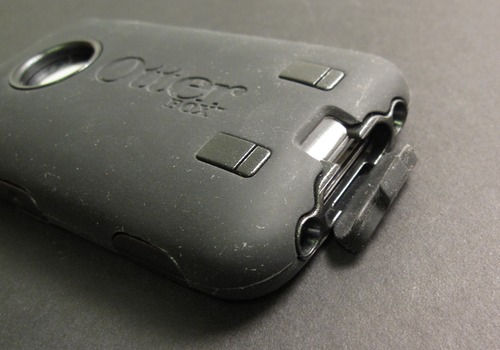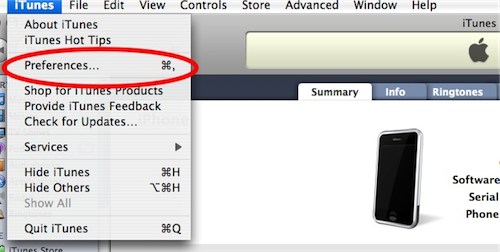
The Otterbox Defender case ($20) for the iPhone 3G/3GS offers the most protection we’ve seen in an iPhone case yet. It surrounds your iPhone with a fortress of hard plastic, soft silicone, and screen protectors, leaving almost no gap unprotected. But protection requires sacrifice, and for the Defender, that sacrifice is convenience. While gaining superb protection from smashes and scractches, you’ll lose dockability, quick access to the iPhone’s ports, and the iPhone’s slim profile.
We wish we could say there was one iPhone case that offered it all: complete protection, minimal profile, lightweight, full access, and slick design. Instead, there are just well-made cases designed toward a purpose like fashion, slim profiles, or protection. The Otterbox Defender is designed for consumers who abuse their iPhones.
For protection, the case is composed of two parts: a hard plastic interior and a soft, shock-absorbing exterior. The hard plastic interior snaps together around the iPhone with clasps that lock the two pieces together. Over that goes a soft silicone rubber skin. Together the pieces offer excellent shock absorption for accidental drops.
The outer soft silicone shell also covers the various iPhone ports (headphones, dock, and ringer switch) with rubber tabs that can be opened and closed depending on whether the port is being put to use. This feature is perhaps the case’s biggest negative in terms of conveinence. Want to use the headphones? You’ll have to open the rubber tab, then close it when you’re finished. Same for the USB cable and access to the ringer switch.
Thankfully, the case’s coverage for the iPhone’s home button, sleep button, and ringer switch lacks this “rubber latch” approach. Instead raised areas of soft silicone cover the buttons to simulate the tactile feel. We’ve loved this approach on other cases in the past (when done right), and here our feelings are no different. The buttons are comfortable to use and are accurate when pressed. I personally prefer the soft feel of rubber buttons over using the iPhone’s hard plastic.
The Defender is one of the thickest cases we’ve tested. It more than doubles the iPhone’s thickness and adds several ounces of weight. The size of the Defender also prevents the iPhone from being used in docks—even Universal docks are off limits. Even so, we had no problem pocketing the iPhone with the case on. But then again, we also don’t wear skinny jeans.

A clear plastic screen protector is attached to the case (not removable) and covers the front iPhone screen. We generally don’t recommend screen protectors, and Apple seems to agree with us as they recently pulled all screen protectors from their online and retail stores. Our main reasoning has to do with loss of screen sensitivity, and some does occur with the Defender. It’s something you get used to by applying firmer pressure on your taps, but it still leads to more frustrating misstaps in the long run. These clear plastic covers also lack Apple’s special coating and attract more finger grease. Still, we recognize there are those who desire that extra protection for the screen, and the Defender offers an all-in-one solution for protection of the iPhone’s body and screen.
The same clear plastic used to protect the screen also covers the camera lens and the Apple logo on the back. A black plastic rim surround the clear plastic gives it a ship’s porthole look.

Testing the Defender over a span of a few weeks, we noted the extra work required to use the iPhone with the case on. For example, frequently opening and closing the rubber silicone tabs took some getting used to. We also had to shed our iPhone dock and move back to using just the USB cable, as removing the case to dock the iPhone would take several minutes. We also noted the Defender’s centimeter-high plastic ridge around the screen that made access to the extreme corners of the screen difficult.
Conclusion
If you need ultimate protection for your iPhone, the Otterbox Defender is the best case we’ve seen toward that purpose. But safety means sacrifice, and you’ll lose some convenience due the case’s bulk and features. It’s hard to quantify such a specialized case with a number rating, but overall the case is well-designed and built with rugged, solid materials. With that in mind, we give the Defender a 9.1 out of 10 rating but include the following caveat: highly recommended for consumers looking for heavy protection, not recommended for those looking for a slim, unobstrusive iPhone case.

















I have two iPhones each with Defender cases on them. You are right about the docking, but needed to add the inability to use most non-OEM aftermarket connectors won’t fit into the plastic oval hole created by the Otterbox. I find the sensitivity to operate the iPhone in the Otterbox just fine. There is still the original screen protector put on in the AT&T store and it still has adequate sensitivity for me. Overall, the peace of mind knowing I have such protection around my phone is more than enough compensation for the shortcomings of having to move rubber plugs out of the way.